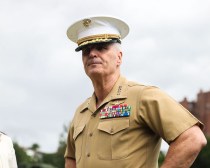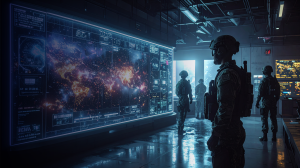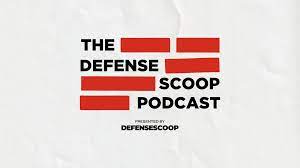New ‘irregular triad’ gaining currency as operational concept to improve deterrence

As officials and experts are calling for more integration of irregular warfare capabilities to defeat adversaries, a new modern “triad” concept for the U.S. military is being touted as a jumping-off point for deterrence.
The so-called cyber-special operations forces-space triad or “irregular triad,” is a partnership between the three disciplines to deliver capabilities and outcomes greater than the sum of its parts, leveraging the unique access and authorities of each contributor. While officials explained this fusion of capabilities came about in tabletop exercises years ago, the Army began putting it into practice with its relevant components and it’s now making its way to the joint four-star combatant commands.
The strategic environment for the U.S. military is significantly more complex now than it has been in years past, requiring more and different options to deter adversary activity around the globe.
“Some of our adversaries are demonstrating a degree of skill and effectiveness in their employment of irregular warfare that the United States has difficulty matching and the United States has difficulty dealing with,” Mike Nagata, corporate strategic advisor at CACI and a retired three-star general with decades of special operations experience, said Thursday during a panel at the Special Operations Symposium hosted by NDIA. “Many of our competitors and many of our adversaries are adopting modern, powerful digital technologies faster than the United States is. They are not hesitating to use it.”
Experts explained that America’s adversaries have sought to use unconventional, irregular and hybrid tactics as a means of combating the conventional strength of U.S. forces. Much of this is taking place below the threshold of armed conflict.
“Our adversaries, particularly the Chinese but really all of them, are pursuing irregular strategies … It’s a combination of political warfare, economic warfare and irregular warfare. They are pursuing strategies to achieve objectives without having to go to conventional conflict,” said Ken Tovo, president and CEO of DOL Enterprises and a retired three-star general. “Our challenge is, are we ready to play on that field? While we have talked about irregular warfare, and especially in this community for many years, the reality is there’s a lot of things that have actually inhibited our execution of effective irregular warfare strategies around the world to achieve our objectives.”
Current officials explained that the modern triad provides an existing operational concept that is operating currently and can act as a deterrent capability.
“The irregular triad that we’re talking about here is an operational concept,” said Lt. Gen. Richard Angle, commander of Allied Special Operations Forces Command at NATO and Special Operations Command Europe. “It brings together multi-domain capabilities. This concept can, in fact, enable deterrence, because that’s what we’re talking about.”
Officials explained that the three disciplines aren’t as siloed as they may seem, noting inherent integration currently exists.
For example, the Marine Corps and Navy cyber service components to U.S. Cyber Command are also their service components to Space Command. Additionally, Marine Corps Forces Cyberspace Command serves as the coordinating authority for cyber for U.S. Special Operations Command under Cybercom’s Joint Force Headquarters-Cyber enterprise. Similarly, 16th Air Force/Air Forces Cyber, a service cyber component to Cybercom, is the coordinating authority for cyber for U.S. Space Command under its Joint Force Headquarters-Cyber.
“The area that I’ve been most proud of is the fact that we have aggressively taken this from a conceptual discussion to one where we’re doing operational activities together and doing it routinely and how we are able to come together to bring our respective strengths,” Gen. Timothy Haugh, commander of Cybercom, said. “Overall, where we’ve come together has been driven by we can produce better outcomes together in those situations, particularly on really hard problems, and the fact that the initial investments we’ve made to do that have produced outcomes just reinforces the need for us to be able to collaborate in our planning and also in how we approach problems together. Because it gives different options to the secretary than we would have been able to do independently.”
Angle, who also has cyber experience having previously served as deputy commanding general for operations at Army Cyber Command, explained that through deterrence by denial, the triad can make it difficult for adversaries to achieve objectives below the threshold of war.
But, he said, it has to be employed more often if it is to be successful in the future for deterrence, or if deterrence should fail, for managing escalation and crises.
“You need to employ this capability now if you want options later. You can employ it now at low cost, at fairly low risk with potentially high payoffs. By doing so, you can actually lower the risk later because you’re now holding critical adversary capabilities at risk,” Angle said. “The conversation we have to have is here’s also the risk of not taking action. Because if you don’t employ these capabilities, you won’t hold that critical adversary capability at risk when the time comes. We are doing a lot of things inside of this triad, but we have to find a way to do more. We have to find a way to get to the point where we’re doing things and the adversary is reacting to what we’re doing and we’re not reacting to what they’re doing.”
For Haugh, while there have been positive discussions among the relevant stakeholders and good operational applications, he’d like to improve upon what opportunities exist for tighter linkage.
“Today, we have started to put the right pieces in place. Much of what we could also talk about is, when we miss opportunities, why do we miss them? In many of those cases, it’s about the kit that’s available to us at that moment and are we fully using the opportunity for us to be innovative from a technical solution standpoint that fits the timeline of the opportunity of placement and access and the ability to come together around a specific problem,” he said. “I think there’s some things we could talk about what we’re each doing in that area where we could be also more purposeful to be able to fully leverage our respective authorities and how we innovate and how we acquire.”






